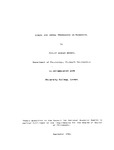Visual and verbal processing in reasoning
| dc.contributor.supervisor | Evans, J. St. B. T. | |
| dc.contributor.author | Brooks, Philip Graham | |
| dc.contributor.other | School of Psychology | en_US |
| dc.date.accessioned | 2011-05-10T14:35:59Z | |
| dc.date.available | 2011-05-10T14:35:59Z | |
| dc.date.issued | 1984 | |
| dc.identifier | Not available | en_US |
| dc.identifier.uri | http://hdl.handle.net/10026.1/350 | |
| dc.description.abstract |
This programme of research, involving seven experiments, investigates Evans' (1980a; 1980b) revised version of the Dual Process theory of reasoning (Wason and Evans, 1975). A Type 2 process is characterised as verbal-rational and a Type I process as non-verbal and non-logical. Evans links the processes to two statistical components of observed reasoning performance. The Type I process reflects non-logical response biases and the Type 2 process reflects attention to the logical nature of the task. Six experiments employ a concurrent articulation (with or without a short-term memory load) methodology devised by Baddeley and Hitch (1974) for investigating their Working Memory model. Four experiments apply this technique to conditional reasoning tasks in an attempt to disrupt the verbal Type 2 process. Some weak evidence for the revised Dual Process theory is found. There is a tendency, marked in only one experiment, for concurrent articulation to inhibit logical performance, whilst having little effect on response biases. Unexpectedly, articulation conditions (without memory load) are characterised by faster responding than silent conditions. The results are inconsistent with Hitch and Baddeley's (1976) data and several features of their Working Memory model. Two further experiments repeat and extend their work. A number of important theoretical implications are discussed in the light of recent revisions to their theory (eg. Baddeley, 1983). A possible connection is drawn between Type I and Type 2 processes and dual memory codes (Paivio, 1971; 1983) and thought systems (Paivio, 1975) of a verbal and visual nature. The hypothesis that Type I processes may be associated with visual mechanisms is tested by introducing a factor into three experiments to induce use of a visual code. This does not affect the Type 1 process but facilitates lo3ical performance. These results are discussed in relation to the revised Dual Process theory. An explanation in terms of a recent tricoding model for processing of pictures and words (Snodgrass, 1980; 1984) is suggested. | en_US |
| dc.description.sponsorship | Science and Engineering Research Council | en_US |
| dc.language.iso | en | en_US |
| dc.publisher | University of Plymouth | en_US |
| dc.title | Visual and verbal processing in reasoning | en_US |
| dc.type | Thesis | |
| dc.identifier.doi | http://dx.doi.org/10.24382/4274 | |
| dc.identifier.doi | http://dx.doi.org/10.24382/4274 |
Files in this item
This item appears in the following Collection(s)
-
01 Research Theses Main Collection
Research Theses Main


